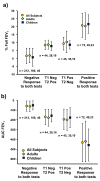Reproducibility of the airway response to an exercise protocol standardized for intensity, duration, and inspired air conditions, in subjects with symptoms suggestive of asthma
- PMID: 20807446
- PMCID: PMC2939602
- DOI: 10.1186/1465-9921-11-120
Reproducibility of the airway response to an exercise protocol standardized for intensity, duration, and inspired air conditions, in subjects with symptoms suggestive of asthma
Abstract
Background: Exercise testing to aid diagnosis of exercise-induced bronchoconstriction (EIB) is commonly performed. Reproducibility of the airway response to a standardized exercise protocol has not been reported in subjects being evaluated with mild symptoms suggestive of asthma but without a definite diagnosis. This study examined reproducibility of % fall in FEV1 and area under the FEV1 time curve for 30 minutes in response to two exercise tests performed with the same intensity and duration of exercise, and inspired air conditions.
Methods: Subjects with mild symptoms of asthma exercised twice within approximately 4 days by running for 8 minutes on a motorized treadmill breathing dry air at an intensity to induce a heart rate between 80-90% predicted maximum; reproducibility of the airway response was expressed as the 95% probability interval.
Results: Of 373 subjects challenged twice 161 were positive (≥ 10% fall FEV1 on at least one challenge). The EIB was mild and 77% of subjects had <15% fall on both challenges. Agreement between results was 76.1% with 56.8% (212) negative (< 10% fall FEV1) and 19.3% (72) positive on both challenges. The remaining 23.9% of subjects had only one positive test. The 95% probability interval for reproducibility of the % fall in FEV1 and AUC0-30 min was ± 9.7% and ± 251% for all 278 adults and ± 13.4% and ± 279% for all 95 children. The 95% probability interval for reproducibility of % fall in FEV1 and AUC0-30 min for the 72 subjects with two tests ≥ 10% fall FEV1 was ± 14.6% and ± 373% and for the 34 subjects with two tests ≥ 15% fall FEV1 it was ± 12.2% and ± 411%. Heart rate and estimated ventilation achieved were not significantly different either on the two test days or when one test result was positive and one was negative.
Conclusions: Under standardized, well controlled conditions for exercise challenge, the majority of subjects with mild symptoms of asthma demonstrated agreement in test results. Performing two tests may need to be considered when using exercise to exclude or diagnose EIB, when prescribing prophylactic treatment to prevent EIB and when designing protocols for clinical trials.
Figures







Similar articles
-
[Standard technical specifications for methacholine chloride (Methacholine) bronchial challenge test (2023)].Zhonghua Jie He He Hu Xi Za Zhi. 2024 Feb 12;47(2):101-119. doi: 10.3760/cma.j.cn112147-20231019-00247. Zhonghua Jie He He Hu Xi Za Zhi. 2024. PMID: 38309959 Chinese.
-
Ventilatory Demand During Stepping and Running: Implications for Exercise-Induced Bronchoconstriction in Children.Respir Care. 2019 Apr;64(4):445-452. doi: 10.4187/respcare.06363. Epub 2019 Feb 5. Respir Care. 2019. PMID: 30723167
-
Exercise test using dry air in random adolescents: Temporal profile and predictors of bronchoconstriction.Respirology. 2016 Feb;21(2):289-96. doi: 10.1111/resp.12682. Epub 2015 Nov 20. Respirology. 2016. PMID: 26588807 Clinical Trial.
-
Exercise-induced bronchoconstriction and asthma.Evid Rep Technol Assess (Full Rep). 2010 Jan;(189):1-154, v-vi. Evid Rep Technol Assess (Full Rep). 2010. PMID: 20726625 Free PMC article. Review.
-
[Exercise-induced bronchoconstriction].Pneumonol Alergol Pol. 2011;79(1):39-47. Pneumonol Alergol Pol. 2011. PMID: 21190152 Review. Polish.
Cited by
-
Pediatric exercise-induced bronchoconstriction: contemporary developments in epidemiology, pathogenesis, presentation, diagnosis, and therapy.Curr Allergy Asthma Rep. 2013 Dec;13(6):662-71. doi: 10.1007/s11882-013-0380-x. Curr Allergy Asthma Rep. 2013. PMID: 23925985 Review.
-
Exercise-Induced Bronchoconstriction Identified Using the Forced Oscillation Technique.Front Physiol. 2019 Nov 15;10:1411. doi: 10.3389/fphys.2019.01411. eCollection 2019. Front Physiol. 2019. PMID: 31803065 Free PMC article.
-
Self-reported exercise-induced dyspnea and airways obstruction assessed by oscillometry and spirometry in adolescents.Pediatr Allergy Immunol. 2022 Jan;33(1):e13702. doi: 10.1111/pai.13702. Epub 2021 Dec 9. Pediatr Allergy Immunol. 2022. PMID: 34797002 Free PMC article.
-
Vigorous Exercise Can Cause Abnormal Pulmonary Function in Healthy Adolescents.Ann Am Thorac Soc. 2015 Jun;12(6):872-7. doi: 10.1513/AnnalsATS.201411-520OC. Ann Am Thorac Soc. 2015. PMID: 25909448 Free PMC article.
-
Role of Spirometry, Radiology, and Flexible Bronchoscopy in Assessing Chronic Cough in Children.J Clin Med. 2024 Sep 25;13(19):5720. doi: 10.3390/jcm13195720. J Clin Med. 2024. PMID: 39407780 Free PMC article. Review.
References
-
- Anderson SD. In: Allergy & Allergic Diseases. Kay AB, editor. Oxford: Blackwell Scientific Publications; 1997. Exercise-induced asthma.
-
- Sterk PJ, Fabbri LM, Quanjer PH, Cockcroft DW, O'Byrne PM, Anderson SD, Juniper EF, Malo J-L. Airway responsiveness: Standardized challenge testing with pharmacological, physical and sensitizing stimuli in adults. Eur Respir J. 1993;6(Suppl 16):53–83. - PubMed
-
- Crapo RO, Casaburi R, Coates AL, Enright PL, Hankinson JL, Irvin CG, MacIntyre NR, McKay RT, Wanger JS, Anderson SD, Cockcroft DW, Fish JE, Sterk PJ. Guidelines for methacholine and exercise challenge testing - 1999. Am J Respir Crit Care Med. 2000;161(1):309–329. - PubMed

